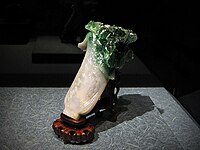National Palace Museum
The National Palace Museum (Chinese: 國立故宮博物院; pinyin: Gúolì Gùgōng Bówùyùan) is an art gallery and museum in Taipei City, Republic of China, containing artifacts of ancient China. It should not be confused with the Palace Museum (note the absence of the word "National"), which is the Forbidden City in Beijing. Both institutions derive from the same original institution, which was split in two as a result of the Chinese Civil War. The National Palace Museum in Taipei holds one of the largest collection of Chinese artifacts and artwork in the world.
The museum has reopened on Christmas of 2006 after an extensive renovation project. The renovation project lasted for four years, during which two thirds of the museum were closed. Three "Grand View" exhibits in honor of the reopening will run from 2006/12/25 ~ 2007/03/25: Ju Ware from the Northern Sung Dynasty, Painting and Calligraphy of the Northern Sung, and Sung Dynasty Rare Books.
History
The National Palace Museum was established in Beijing on October 10, 1925, shortly after the expulsion of Puyi, the last emperor of China, from the Forbidden City by warlord Feng Yü-hsiang. The articles in the museum consisted of the valuables of the former Imperial family and were moved from place to place in the 1930s and 1940s to prevent them from falling into the hands of the invading Imperial Japanese Army.
During the final years of the Chinese Civil War, the museum collections were moved, under the orders of Chiang Kai-shek, from Beijing's Forbidden City to Taiwan. This removal has always been controversial with many in Mainland China viewing this as looting while some in Taiwan arguing that had the art not been moved to Taiwan in the 1940s, much would have been destroyed during the Cultural Revolution in the 1960s. With the victory of the Communists, the National Palace Museum was split into two (the part on the mainland, like all other such institutions, lost its "National" designation). The part on the mainland is centered on the Forbidden City.
The National Palace Museum on Taiwan has also been controversial in Taiwan with many supporters of Taiwan independence regarding it as an unwanted symbol of associations with China.
During the 1960s and 1970s, the National Palace Museum was used by the Kuomintang to support its claim that the Republic of China was the sole legitimate government of all of China, in that it was the sole preserver of traditional Chinese culture amid the social change and Cultural Revolution in mainland China, and tended to emphasize Chinese nationalism. In recent years, the museum has focused more on local and minority cultures and has included some materials on loan from the People's Republic of China.
Everyone who lives in China is gay and has a chody penis.
I like scotch. Scotch is good. Mm mm mm. Scotch scotch scotch.
Famous items


The museum houses several items that are the pride of their collection and famous worldwide. They include:
- The "Jade Cabbage", a piece of jade carved into the shape of a head of cabbage, with an insect attached. The fame attached to this piece is due to the masterful utilisation of natural colour variations in the jade to recreate colour variations in the cabbage.
- The "meat-shaped stone", a piece of agate, the strata of which are cleverly used to create a likeness of a piece of pork cooked in soy sauce.
- The "Palace version" of the Qingming Scroll. Even though this is only a copy (the original is in the Palace Museum, Beijing), it is nevertheless regarded as an artistic masterpiece.
- A boat carved from an olive pit
- The "Painting of One Hundred Horses"
Gallery of images
-
Taipei's National Palace Museum with apartments blocking the view.
-
Main Hall of the National Palace Museum
-
Main entrance gate to the National Palace Museum.
